
During my time here in India I have seen many beautiful sights. Today was no exception. The most sacred Sikh temple is the Golden Temple located in Amritsar. The moment you first lay eyes on the temple it is almost too overwhelming to describe. The temple stands large and impressive, shining with a brilliance that can take your breath away. Surrounded on all sides by water, the temple’s reflection is almost as magnificent as the real thing. Despite the early hour of our arrival there were already thousands of people waiting to experience something they consider to be very holy. Everywhere we looked we saw adults and children bathing in the holy waters, men on their knees praying, and families slowly moving through the crowd towards the temple.
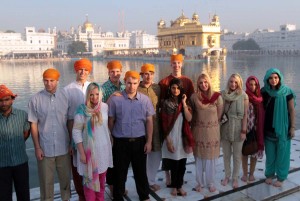
The Sikh religion is the 7th largest organized religion in the world, but I did not grasp the significance of this until today. The number of people that decided to visit the temple on the same day, during the same hour, as us was astounding and yet, this was still only a small fraction of the number they receive. The golden temple gets an average of 100,000 to 200,000 visitors a day, and on days with special services the numbers can be uncountable. Being witness to so many people having a religiously significant experience was both compelling and humbling. You could plainly see that everyone present was invested in the experience and grateful to be there. I feel extremely lucky that I was able to have this once in a lifetime experience.

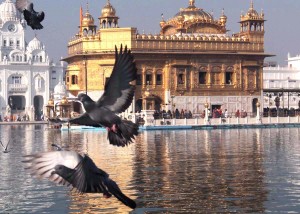
In India lines function differently than they do back home. In place of orderly rows of disgruntled people, you encounter a mass of people, all pressed together, moving forward in surges. I now know how a sardine must feel. In line at the Golden Temple everyone was so packed in that when the crowed moved forward, I moved forward.
When we finally reached the entrance to the Golden Temple I was astonished to find that “golden temple” was no exaggeration. The entire inside of the temple was gold. When you looked to the side you saw gold walls. When you looked up you saw a gold ceiling, complete with gold ceiling fans. In the center of the temple there were three men playing instruments and continuously chanting a prayer. A set of speakers carried the chanting throughout the entire compound.

Walking through the alleyway into Jallianwala Bagh, was like walking through fog and not knowing what to expect on the other side. I tried to picture the British soldiers running through the passage, armed and ready to kill the hundreds of innocent protesters enclosed within the courtyard walls. The historic massacre occurred in that very spot, at the end of the passage, in 1919.
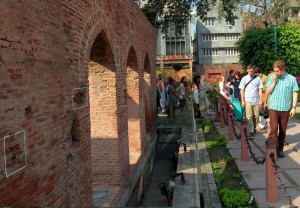
When we entered the courtyard we saw that it was beautifully landscaped. I could not grasp the fact that so many people were murdered there, even while looking at the walls that were still indented with bullet holes. It was horrifying to know how the people desperately tried to find a way out. They struggled to climb up the walls, but were shot instantly. Some even jumped into a well to escape, but none survived.
Inside the museum was a very detailed painting of the massacre. The painting made the event seem less theoretical and I was hit with emotion. Hanging on the walls of the museum were paintings of men and women all of whom had fought and died to free India from colonial rule. Next to each painting was a writing explaining their sacrifice. Each face brought a sense of realism to the event, each death a loss rather than a historical event. As we left the building I was overcome with appreciation for the world of freedom and justice I live in.

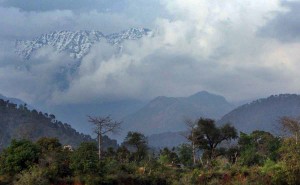
This morning, after visiting the Golden Temple, we left Amritsar for Dharamsala. The drive was an adventure filled with heavy traffic, obstacles and fallen suitcases. Gradually the traffic gave way to a curvy mountain road barely wide enough for a motorcycle. As we began the climb up, the hills got steeper and steeper until they gave way to looming mountains. A window opened in the billowing clouds and I caught my first glimpse of the mighty Himalayas. The snowcapped peaks are so awe-inspiring that it is easy to see why the Himalayas are the home of the Hindu gods.
When we finally arrived in Dharamsala, I was struck by the spirituality of the place. I have been looking forward to this leg of the trip for months and being here is surreal. Watching monks hike up the narrow streets and vendors selling fruits, vegetables and other knick-knacks is amazing. I can’t wait to explore this community nestled in the Himalayan foothills.

After our visit to the Golden Temple and Jallianwala Bagh we drove to Dharamsala, the home of the Tibetan government in exile and the Dalai Lama. The fertile mountains that make up the foothills of the Himalayas were a beautiful contrast to the flat grasslands in which we have spent most of our time.
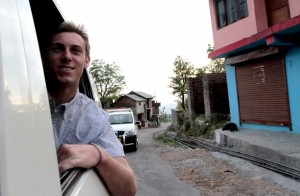
As our altitude increased, a new world revealed itself, displaying its distinct flora, fauna and people. The population was much more sparse in the foothills giving way to a different way of life. Houses were farther apart which allowed for a more sanitary environment, despite the rural lifestyle. An increased number of cows and water buffalo wandered freely across the twisting mountain roads. Mountain goats and sheep joined the region’s collection of animals, and tall trees that resembled pines formed a comfortable tree cover. Green was the prevalent color of the landscape but bright, multi-colored wildflowers added excitement to the mosaic. Water-rounded stones made riverbeds for streams of snowmelt. These brooks weaved through rock and poured from ledges onto our path. Heavy clouds rubbed up against the peaks and the air temperature dropped to a level reminiscent of Mount Madonna.
My excitement grew during the final hour of the drive as we scaled the hill toward the Tibetan Children’s Village. The switchback road gave an alternating view of the snow- capped mountains above and the vivid valley below. The town of Dharmasala seemed more inviting than the other cities we have visited. Monks walked by houses and shops, which hugged the steep hillside. The demographic shifted to include more Tibetans, which reflects the historical background of the community. After arriving at our hotel, I peered down at the path we had traveled and realized that it is now time for me to prepare myself mentally for the next chapter of our journey.
I love your vivid descriptions of what you are seeing and feeling. It is amazing how one can feel awe, inspiration, humility, gratitude, sadness and compassion all within a day. India does indeed elicit them all.
Thank you, Shmuel for the incredible photos.
Safe journey!
I appreciate the diversity of your insights from the same day and am so thrilled that you are finding truly touching and awe-inspiring moments. Treasure them!